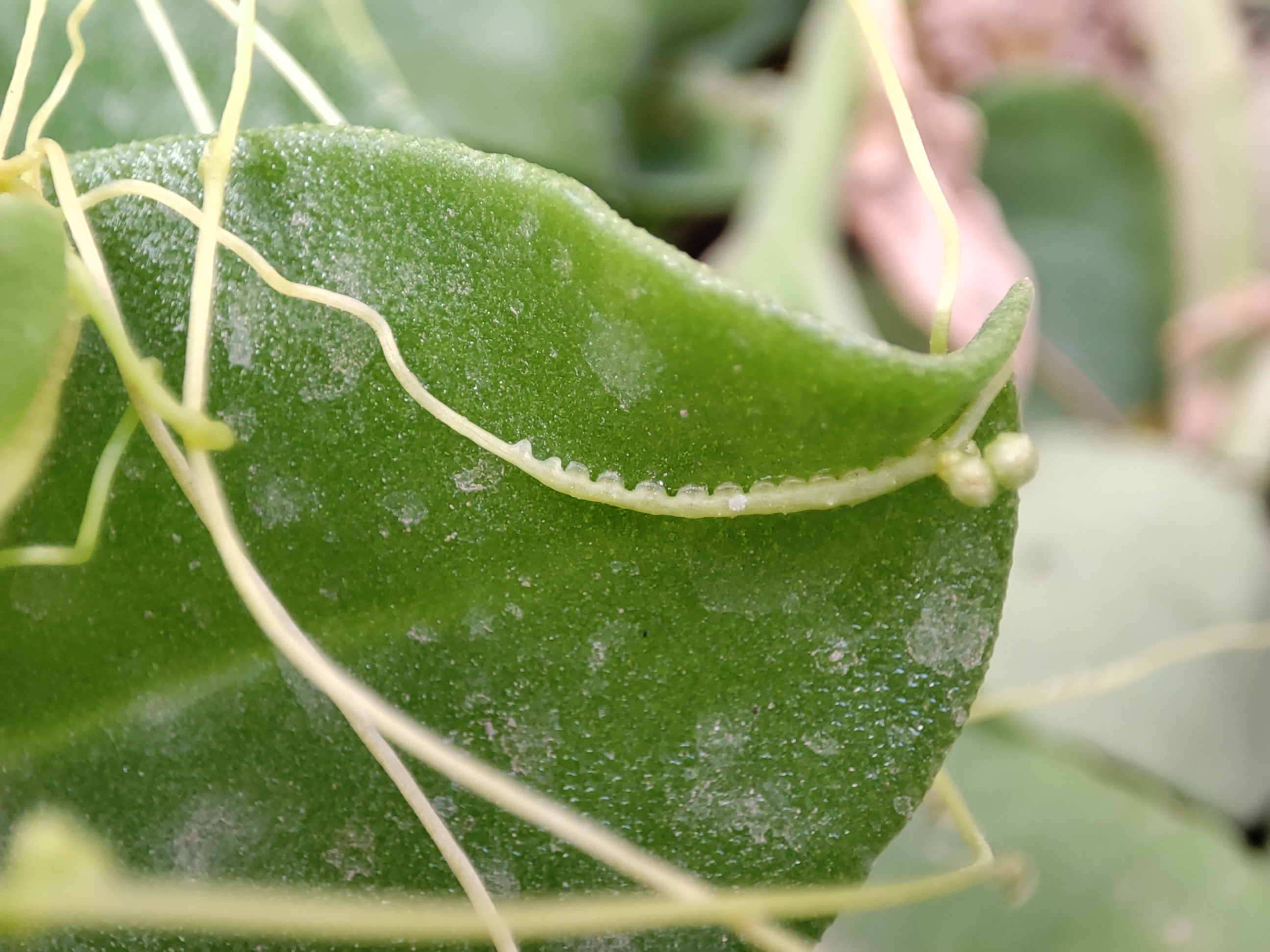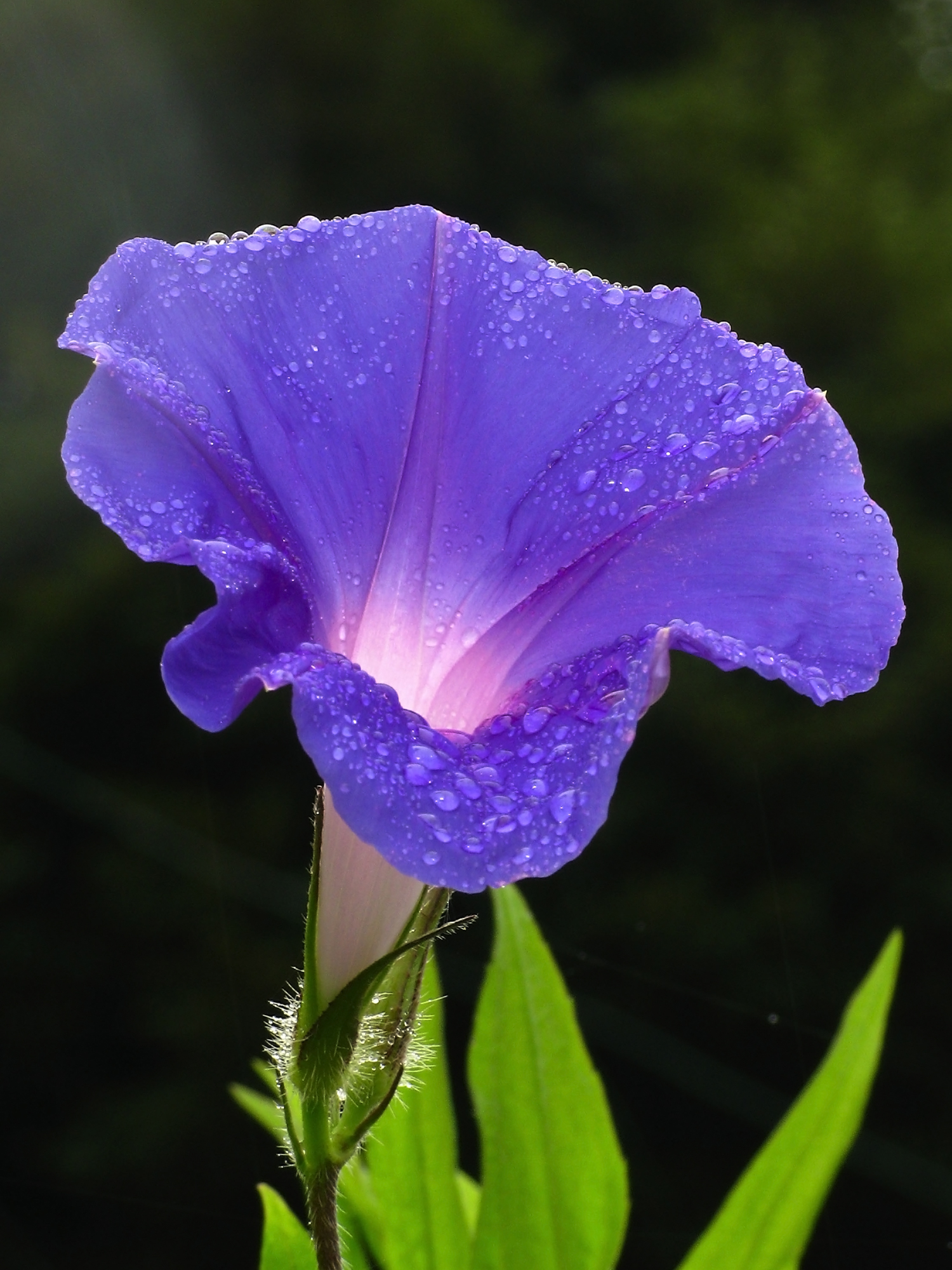|
Convolvulaceae
Convolvulaceae (), commonly called the bindweeds or morning glories, is a family of about 60 genera and more than 1,650 species. These species are primarily herbaceous vines, but also include trees, shrubs and herbs. The tubers of several species are edible, the best known of which is the sweet potato. Description Convolvulaceae can be recognized by their funnel-shaped, radially symmetrical corolla; the floral formula for the family has five sepals, five fused petals, five epipetalous stamens (stamens fused to the petals), and a two-part syncarpous and superior gynoecium. The stems of these plants are usually winding, hence their Latin name (from ''convolvere'', "to wind"). The leaves are simple and alternate, without stipules. In parasitic Cuscuta (dodder) they are reduced to scales. The fruit can be a capsule, berry, or nut, all containing only two seeds per one locule (one ovule/ovary). The leaves and starchy, tuberous roots of some species are used as foodstuffs (e.g. ... [...More Info...] [...Related Items...] OR: [Wikipedia] [Google] [Baidu] |
Cuscuta
''Cuscuta'' (), commonly known as dodder or amarbel, is a genus of over 201 species of yellow, orange, or red (rarely green) parasitic plants. Formerly treated as the only genus in the family Cuscutaceae, it now is accepted as belonging in the morning glory family, Convolvulaceae, on the basis of the work of the Angiosperm Phylogeny Group. The genus is found throughout the temperate and tropical regions of the world, with the greatest species diversity in subtropical and tropical regions; the genus becomes rare in cool temperate climates, with only four species native to northern Europe. Folk names include: strangle tare, scaldweed, beggarweed, lady's laces, fireweed, wizard's net, devil's guts, devil's hair, devil's ringlet, goldthread, hailweed, hairweed, hellbine, love vine, pull-down, strangleweed, angel hair, and witch's hair. Description Cuscuta can be identified by its thin stems appearing leafless, with the leaves reduced to minute scales. In these respects it closel ... [...More Info...] [...Related Items...] OR: [Wikipedia] [Google] [Baidu] |
Morning Glory
Morning glory (also written as morning-glory) is the common name for over 1,000 species of flowering plants in the family Convolvulaceae, whose current taxonomy and systematics are in flux. Morning glory species belong to many genus, genera, some of which are: * ''Argyreia'' * ''Astripomoea'' * ''Calystegia'' * ''Convolvulus'' * ''Ipomoea'' (the largest genus) * ''Lepistemon'' * ''Merremia'' * ''Operculina'' * ''Rivea'' * ''Stictocardia'' As the name suggests, most ''morning'' glory flowers unfurl into full bloom in the early morning. The flowers usually start to fade a few hours before the corolla begins to display visible curling. They prefer full solar exposure throughout the day, and Mesic habitat, mesic soils. Some morning glories, such as ''Ipomoea muricata'', ''Ipomoea alba'', and ''Ipomoea macrorhiza'', are night-blooming flowers. History ''Ipomoea nil'', a species of morning glory, was first known in China for its medicinal uses, due to the laxative properties of i ... [...More Info...] [...Related Items...] OR: [Wikipedia] [Google] [Baidu] |
Ergoline
Ergoline is a chemical compound whose structural skeleton is contained in a variety of alkaloids, referred to as ergoline derivatives or ergoline alkaloids. Ergoline alkaloids, one being ergine, were initially characterized in ergot. Some of these are implicated in the condition ergotism, which can take a convulsive form or a gangrenous form. Even so, many ergoline alkaloids have been found to be clinically useful. Annual world production of ergot alkaloids has been estimated at 5,000–8,000 kg of all ergopeptines and 10,000–15,000 kg of lysergic acid, used primarily in the manufacture of semi-synthetic derivatives. Others, such as lysergic acid diethylamide, better known as LSD, a semi-synthetic derivative, and ergine, a natural derivative found in ''Argyreia nervosa'', ''Ipomoea tricolor'' and related species, are known psychedelic substances. Natural occurrence Ergoline alkaloids are found in lower fungi and some species of flowering plants: the Mexican specie ... [...More Info...] [...Related Items...] OR: [Wikipedia] [Google] [Baidu] |
Convolvulus
''Convolvulus'' is a genus of about 200 to 250''Convolvulus''. Flora of China.''Convolvulus'' The Jepson eFlora. 2013. species of s in the bindweed family ,Parnell, J. and Curtis, T. 2012. ''Webb's An Irish Flora''. Cork University Press. with a [...More Info...] [...Related Items...] OR: [Wikipedia] [Google] [Baidu] |
Sweet Potato
The sweet potato or sweetpotato ('' Ipomoea batatas'') is a dicotyledonous plant that belongs to the bindweed or morning glory family, Convolvulaceae. Its large, starchy, sweet-tasting tuberous roots are used as a root vegetable. The young shoots and leaves are sometimes eaten as greens. Cultivars of the sweet potato have been bred to bear tubers with flesh and skin of various colors. Sweet potato is only distantly related to the common potato (''Solanum tuberosum''), both being in the order Solanales. Although darker sweet potatoes are often referred to as "yams" in parts of North America, the species is not a true yam, which are monocots in the order Dioscoreales. Sweet potato is native to the tropical regions of the Americas. Of the approximately 50 genera and more than 1,000 species of Convolvulaceae, ''I. batatas'' is the only crop plant of major importance—some others are used locally (e.g., ''I. aquatica'' "kangkong"), but many are poisonous. The genus ''Ipomo ... [...More Info...] [...Related Items...] OR: [Wikipedia] [Google] [Baidu] |
Jacquemontia Paniculata W IMG 2929
''Jacquemontia'' is a genus of plants in the morning glory family Convolvulaceae. Species in this genus are commonly known as clustervine. Species Over one hundred species are recognised: * ''Jacquemontia abutiloides'' * ''Jacquemontia acrocephala'' * ''Jacquemontia acuminata'' * ''Jacquemontia aequisepala'' * ''Jacquemontia albida'' * ''Jacquemontia anomala'' * ''Jacquemontia asarifolia'' * ''Jacquemontia bahiensis'' * ''Jacquemontia blanchetii'' * '' Jacquemontia bracteosa'' * ''Jacquemontia browniana'' * ''Jacquemontia capitellata'' * ''Jacquemontia cataractae'' * '' Jacquemontia caudata'' * '' Jacquemontia cayensis'' * '' Jacquemontia cearensis'' * '' Jacquemontia cephalantha'' * '' Jacquemontia chrysanthera'' * '' Jacquemontia confusa'' * '' Jacquemontia corymbulosa'' * '' Jacquemontia cumanensis'' * '' Jacquemontia curtissii'' * '' Jacquemontia cuyabana'' * '' Jacquemontia decipiens'' * ''Jacquemontia densiflora'' * ''Ja ... [...More Info...] [...Related Items...] OR: [Wikipedia] [Google] [Baidu] |
Ipomoea Aquatica
''Ipomoea aquatica'', widely known as water spinach, is a semi- aquatic, tropical plant grown as a vegetable for its tender shoots. ''I. aquatica'' is generally believed to have been first domesticated in Southeast Asia. It is widely cultivated in Southeast Asia, East Asia, and South Asia. It grows abundantly near waterways and requires little to no care. Description ''Ipomoea aquatica'' grows in water or on moist soil. Its stems are or longer, rooting at the nodes, and they are hollow and can float. The leaves vary from typically sagittate (arrow head-shaped) to lanceolate, long and broad. The flowers are trumpet-shaped, in diameter, and usually white in colour with a mauve centre. Propagation is either by planting cuttings of the stem shoots, which will root along nodes, or by planting the seeds from flowers that produce seed pods. Names ''Ipomoea aquatica'' is widely known as kangkong (also spelled kangkung), its common name in Maritime Southeast Asia, which possibly o ... [...More Info...] [...Related Items...] OR: [Wikipedia] [Google] [Baidu] |
Ipomoea Imperati
''Ipomoea imperati'', the beach morning-glory (a name it shares with '' Ipomoea pes-caprae''), is a species of flowering plant in the family Convolvulaceae. Like ''Ipomoea pes-caprae'', its seeds disperse by floating in seawater. It has been found on the sandy shores of every continent except Antarctica. ''Ipomoea imperati'' and ''I. pes-caprae'' can be easily can be distinguished in that ''I. imperati'' has white flowers and ''I. pes-caprae'' usually has purple flowers. The leaves of ''I. imperati'' are more linear or lanceolate while those of ''I. pes-caprae'' tend to be more circular or ovate. It is considered an invasive species in some places. References imperati Plants described in 1866 {{Solanales-stub ... [...More Info...] [...Related Items...] OR: [Wikipedia] [Google] [Baidu] |
Bindweed '', blue bindweed
{{Plant common name ...
Bindweed may refer to: * Some species of Convolvulaceae (bindweed family or morning glory family): ** '' Calystegia'' (bindweed, false bindweed, morning glory), a genus of about 25 species of flowering plants ** ''Convolvulus'' (bindweed, morning glory), a genus of about 250 species of flowering plants ** ''Polymeria calycina'', slender bindweed, native to Australia * ''Dioscorea communis'', black bindweed * '' Fallopia convolvulus'', black bindweed, a fast-growing annual flowering plant * ''Solanum dulcamara ''Solanum dulcamara'' is a species of vine in the genus ''Solanum'' (which also includes the potato and the tomato) of the family Solanaceae. Common names include bittersweet, bittersweet nightshade, bitter nightshade, blue bindweed, Amara Dulci ... [...More Info...] [...Related Items...] OR: [Wikipedia] [Google] [Baidu] |
Herbaceous
Herbaceous plants are vascular plants that have no persistent woody stems above ground. This broad category of plants includes many perennials, and nearly all annuals and biennials. Definitions of "herb" and "herbaceous" The fourth edition of the '' Shorter Oxford English Dictionary'' defines "herb" as: #"A plant whose stem does not become woody and persistent (as in a tree or shrub) but remains soft and succulent, and dies (completely or down to the root) after flowering"; #"A (freq. aromatic) plant used for flavouring or scent, in medicine, etc.". (See: Herb) The same dictionary defines "herbaceous" as: #"Of the nature of a herb; esp. not forming a woody stem but dying down to the root each year"; #"BOTANY Resembling a leaf in colour or texture. Opp. scarious". Botanical sources differ from each other on the definition of "herb". For instance, the Hunt Institute for Botanical Documentation includes the condition "when persisting over more than one growing season, the p ... [...More Info...] [...Related Items...] OR: [Wikipedia] [Google] [Baidu] |
Stipule
In botany, a stipule is an outgrowth typically borne on both sides (sometimes on just one side) of the base of a leafstalk (the petiole). Stipules are considered part of the anatomy of the leaf of a typical flowering plant, although in many species they may be inconspicuous —or sometimes entirely absent, and the leaf is then termed ''exstipulate''. (In some older botanical writing, the term "stipule" was used more generally to refer to any small leaves or leaf-parts, notably prophylls.) The word ''stipule'' was coined by Linnaeus''Concise English Dictionary'' Wordsworth Editions Ltd. 1994, from Latin ''stipula'', straw, stalk. Types of stipules General characteristics The position of stipules on a plant varies widely from species to species, though they are often located near the base of a leaf. Stipules are most common on dicotyledons, where they appear in pairs alongside each leaf. Some monocotyledon plants display stipule-like structures, but only display one per leaf ... [...More Info...] [...Related Items...] OR: [Wikipedia] [Google] [Baidu] |
Purgative
Laxatives, purgatives, or aperients are substances that loosen stools and increase bowel movements. They are used to treat and prevent constipation. Laxatives vary as to how they work and the side effects they may have. Certain stimulant, lubricant and saline laxatives are used to evacuate the colon for rectal and bowel examinations, and may be supplemented by enemas under certain circumstances. Sufficiently high doses of laxatives may cause diarrhea. Some laxatives combine more than one active ingredient. Laxatives may be administered orally or rectally. Types Bulk-forming agents Bulk-forming laxatives, also known as roughage, are substances, such as fiber in food and hydrophilic agents in over-the-counter drugs, that add bulk and water to stools so that they can pass more easily through the intestines (lower part of the digestive tract). Properties * Site of action: small and large intestines * Onset of action: 12–72 hours * Examples: dietary fiber, Metamucil, Citru ... [...More Info...] [...Related Items...] OR: [Wikipedia] [Google] [Baidu] |







